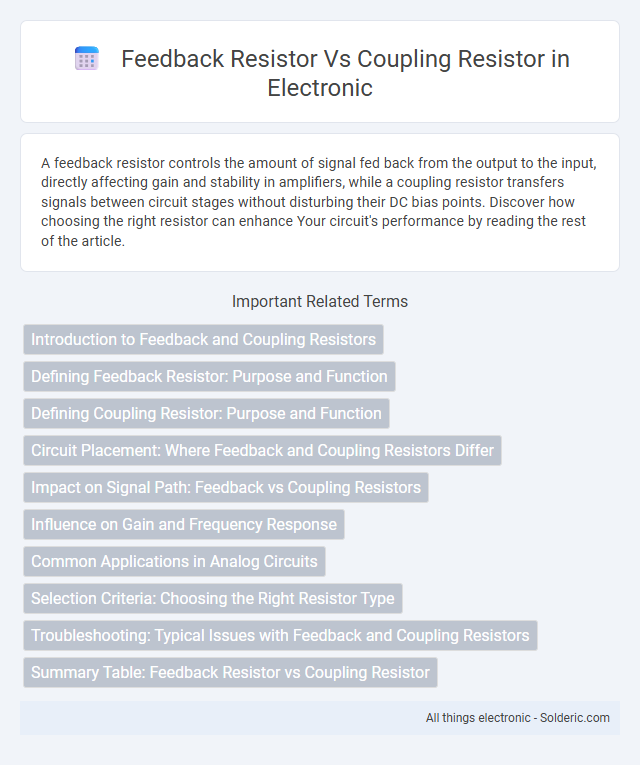A feedback resistor controls the amount of signal fed back from the output to the input, directly affecting gain and stability in amplifiers, while a coupling resistor transfers signals between circuit stages without disturbing their DC bias points. Discover how choosing the right resistor can enhance Your circuit's performance by reading the rest of the article.
Comparison Table
| Aspect | Feedback Resistor | Coupling Resistor |
|---|---|---|
| Function | Controls gain and stability by feeding a portion of output back to input | Separates circuit stages by blocking DC while allowing AC signals |
| Placement | Between output and input of an amplifier | Between two circuit stages or components |
| Signal Role | Regulates feedback loop signal | Transfers AC signal, blocks DC |
| Impact on Circuit | Determines gain, frequency response, and stability | Prevents DC bias shift, isolates stages |
| Typical Usage | Operational amplifier circuits, oscillators | Audio amplifiers, signal processing chains |
Introduction to Feedback and Coupling Resistors
Feedback resistors control the amount of signal fed back from the output to the input, stabilizing gain and improving linearity in amplifiers. Coupling resistors connect different circuit stages, allowing AC signals to pass while blocking DC components, ensuring proper signal transfer. Your choice between these resistors affects circuit performance, gain stability, and signal integrity.
Defining Feedback Resistor: Purpose and Function
A feedback resistor controls the amount of output signal fed back to the input to stabilize gain and improve linearity in amplifiers. It plays a critical role in setting the overall gain by creating a controlled feedback loop. Unlike coupling resistors that facilitate signal transfer between stages, feedback resistors regulate the circuit's response and prevent oscillations.
Defining Coupling Resistor: Purpose and Function
A coupling resistor is designed to link two circuit stages by allowing AC signals to pass while blocking DC components, ensuring signal integrity and proper biasing between stages. It serves to isolate DC operating points while permitting the transfer of variations in voltage that represent the desired signal. Unlike a feedback resistor that controls gain and stability by returning part of the output to the input, the coupling resistor's primary function is to maintain signal continuity without affecting the biasing conditions.
Circuit Placement: Where Feedback and Coupling Resistors Differ
Feedback resistors are typically placed within the amplifier circuit loop, connecting the output back to the input to control gain and stability. Coupling resistors, on the other hand, are positioned between different stages or components to block DC voltage while allowing AC signals to pass through. This distinct circuit placement directly influences their function, with feedback resistors managing signal feedback and coupling resistors enabling signal transfer without DC interference.
Impact on Signal Path: Feedback vs Coupling Resistors
Feedback resistors influence the signal path by controlling the amount of signal fed back from the output to the input, stabilizing gain and reducing distortion in amplifiers. Coupling resistors, on the other hand, primarily isolate different stages by blocking DC components while allowing AC signals to pass, maintaining signal integrity between circuits. The presence of feedback resistors modifies the input impedance and frequency response, whereas coupling resistors mainly affect signal transfer without altering the amplifier's gain structure.
Influence on Gain and Frequency Response
Feedback resistors control gain by forming a feedback loop that stabilizes and sets the overall amplifier gain, directly influencing linearity and bandwidth. Coupling resistors primarily affect frequency response by blocking DC components and allowing AC signals to pass, thus shaping the low-frequency cutoff point in amplifier circuits. Precise selection of feedback and coupling resistors is essential to optimize gain stability and frequency response for specific circuit applications.
Common Applications in Analog Circuits
Feedback resistors are commonly used in analog circuits for setting gain and stability in operational amplifier configurations, ensuring precise voltage control and signal integrity. Coupling resistors serve to block DC components while allowing AC signals to pass between circuit stages, which is essential in audio amplifiers and signal processing. Your circuit's performance relies on selecting the appropriate resistor type to balance feedback accuracy and signal coupling needs.
Selection Criteria: Choosing the Right Resistor Type
Selecting the right resistor type involves understanding the functional role and electrical requirements of feedback and coupling resistors in a circuit. Feedback resistors must have precise tolerance and stability to maintain consistent gain and frequency response in amplifier circuits, while coupling resistors should prioritize low leakage and high impedance to effectively block DC components and pass AC signals without distortion. Your choice depends on parameters such as voltage rating, power dissipation, noise characteristics, and circuit configuration to ensure optimal performance and reliability.
Troubleshooting: Typical Issues with Feedback and Coupling Resistors
Feedback resistors often cause issues such as incorrect voltage levels or oscillations due to wrong resistance values or poor soldering, leading to circuit instability. Coupling resistors commonly face problems like signal attenuation or distortion caused by improper resistance selection or degradation over time. Ensuring correct resistance ratings and verifying connection integrity are critical steps in troubleshooting both feedback and coupling resistor faults.
Summary Table: Feedback Resistor vs Coupling Resistor
Feedback resistors control gain and stability in amplifier circuits by providing a path for a portion of the output signal to the input. Coupling resistors isolate DC biasing between different amplifier stages while allowing AC signals to pass, maintaining signal integrity. The summary table typically highlights feedback resistors' role in gain control and linearity, contrasting with coupling resistors' function in blocking DC components and connecting signal stages.
feedback resistor vs coupling resistor Infographic

 solderic.com
solderic.com